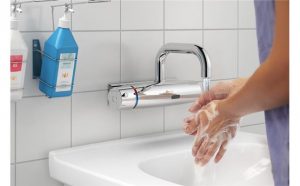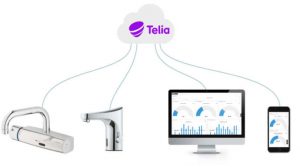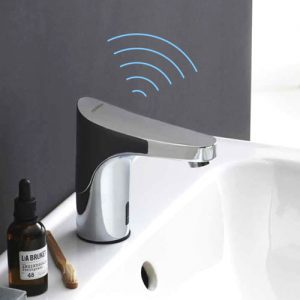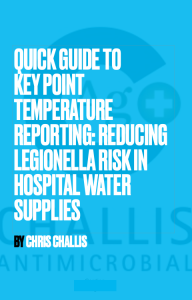1. Introduction
In healthcare settings, water safety is a critical aspect of patient health, particularly with the risks associated with Legionella, a waterborne pathogen known to cause Legionnaires’ disease. Hospital facilities managers face ongoing challenges in maintaining water temperatures that prevent the proliferation of Legionella, and temperature monitoring plays a significant role in controlling these risks.
associated with Legionella, a waterborne pathogen known to cause Legionnaires’ disease. Hospital facilities managers face ongoing challenges in maintaining water temperatures that prevent the proliferation of Legionella, and temperature monitoring plays a significant role in controlling these risks.
Key point temperature reporting provides real-time data that is essential for identifying when water temperatures fall within ranges that promote bacterial growth. However, without actionable responses, facilities may still fall short in addressing risks proactively. Our Water Management System (WMS) not only offers real-time monitoring but also enables automated flushing to reduce temperatures when necessary, ensuring comprehensive water safety.
2. Understanding Legionella and Temperature Management
Legionella bacteria thrive in stagnant water environments with temperatures between 20°C and 45°C (68°F and 113°F). In complex hospital water systems, maintaining temperatures outside this range can be difficult. Facilities managers often rely on periodic testing and manual flushing schedules, which are time-intensive and may not address risks in a timely manner.
Key point temperature monitoring allows facilities managers to observe real-time data on water temperatures at various points in the system. This approach provides a proactive measure in detecting temperature trends that may encourage Legionella growth. While this is a significant improvement, the effectiveness of key point temperature monitoring is limited if there is no action plan to lower temperatures when necessary.
3. The Critical Role of Key Point Temperature Reporting
Key point temperature reporting empowers hospital facilities managers by offering continuous, real- time insight into water temperatures, which is particularly crucial in systems as intricate as those in hospitals. The benefits are clear:
time insight into water temperatures, which is particularly crucial in systems as intricate as those in hospitals. The benefits are clear:
- Patient Safety: Preventing Legionella outbreaks protects vulnerable patients, such as those with weakened immune systems.
- Regulatory Compliance: Key point monitoring assists facilities in meeting UK water safety standards and compliance with Health Technical Memorandum (HTM) 04-01.
- Resource Efficiency: By targeting only areas of concern, this system optimises water usage and reduces the need for continuous manual flushing.
When data is paired with automated actions, such as temperature-based flushing, it maximises these benefits, ensuring that water safety remains continuously controlled.
4. Case Studies: Real-World Applications of Key Point Temperature Management
Case Study 1: Traditional Monitoring vs. WMS Solution
A hospital had previously relied on manual temperature monitoring, with regular checks and manual flushing protocols. Despite these efforts, they experienced a Legionella-positive test due to stagnant water in seldom-used outlets. After adopting the WMS system, they saw a significant reduction in the need for reactive measures. The real-time monitoring and automatic flushing allowed them to detect and address risky temperature zones immediately, resulting in a safer environment and reduced workload for the facilities team.
Case Study 2: Immediate Action to Mitigate Legionella Risks
In another example, a healthcare facility using the WMS system was able to identify a critical temperature spike over a weekend. The system’s automatic flushing was triggered, lowering the water temperature at the source and preventing any possibility of Legionella growth. This incident underscored the value of automated response capabilities, particularly during off-hours when manual intervention would be delayed.
5. Overcoming Limitations of Traditional Facilities Management Platforms
While many facilities management systems provide real-time data, they often lack actionable responses when temperatures reach dangerous levels. In these cases, facilities managers are informed of a potential issue but have no integrated solution for immediate action.
when temperatures reach dangerous levels. In these cases, facilities managers are informed of a potential issue but have no integrated solution for immediate action.
The WMS system addresses this critical gap by pairing real-time data collection with temperature-triggered flushing. When the water temperature exceeds safe limits, the WMS system initiates flushing protocols to cool down the water, preventing the environment that allows Legionella to thrive. This direct action model is vital in reducing risks without requiring additional manual intervention, which is essential in healthcare settings with complex and often demanding infrastructure requirements.
6. Challis WMS: A Comprehensive Solution
 The Challis WMS system has been specifically designed to tackle the unique water safety challenges of healthcare facilities. Here’s how it stands out:
The Challis WMS system has been specifically designed to tackle the unique water safety challenges of healthcare facilities. Here’s how it stands out:
- Real-Time Temperature Monitoring: Continually collects temperature data, instantly alerting managers to any deviations from safe levels.
- Automated Flushing Activation: Automatically initiates flushing when water temperatures reach a pre-set critical threshold, reducing temperatures to safe levels without manual intervention.
- Customisable Settings: Facilities managers can set temperature thresholds that align with site-specific needs, allowing for a tailored approach to water safety.
- Intuitive Dashboard: The WMS system’s user interface provides a comprehensive overview of the hospital’s water system, helping managers quickly identify and address risk areas.
This unique combination of monitoring and action makes the WMS system a reliable and proactive choice for ensuring safe water temperatures in hospital settings.
7. Benefits for Hospital Facilities Managers
By integrating the WMS system, hospital facilities managers gain a suite of benefits that extend well  beyond basic compliance:
beyond basic compliance:
- Enhanced Patient Safety: Real-time and actionable data reduce Legionella risks, safeguarding patients.
- Operational Efficiency: Automated flushing minimises the need for continuous manual checks and interventions.
- Regulatory Assurance: The WMS system supports compliance with healthcare-specific standards, reducing liability and ensuring standards are met.
- Cost Savings: By targeting only necessary outlets, automated flushing reduces both water waste and staff time, leading to long-term savings in operational costs.
These advantages make the WMS system an essential tool for modern healthcare facilities aiming to optimise both safety and efficiency.
8. Call to Action
To learn more about how the Challis WMS system can help your hospital manage water temperatures and combat Legionella risks effectively, contact us today for a demonstration. Our team is ready to assist you with custom solutions tailored to your facility’s unique needs.
Contact Us:
Email: info@challisms.com
Phone: 01628 529024
9. Conclusion
Key point temperature reporting represents a significant advancement in the fight against Legionella in healthcare settings. However, without an actionable solution, facilities managers are left with only half the equation. The Challis WMS system uniquely bridges this gap, combining real-time temperature monitoring with automated flushing capabilities that keep water safe proactively.
We invite you to explore the benefits of the WMS system for your facility and take a crucial step towards safer, more efficient water management in healthcare.

